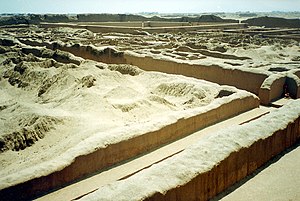|
From top: View over Chan Chan, walls, adobe details, panel of warriors detail | |
| Location | La Libertad Region, Peru |
|---|---|
| Coordinates | 8°6′21″S 79°4′28″W / 8.10583°S 79.07444°W |
| History | |
| Founded | 850 |
| Cultures | Chimú culture |
| Official name | Chan Chan Archaeological Zone |
| Type | Cultural |
| Criteria | i, iii |
| Designated | 1986 (10th session) |
| Reference no. | 366 |
| Region | Latin America and the Caribbean |
| Endangered | 1986–present |
Chan Chan (Spanish pronunciation: [tʃaɲ.'tʃaŋ]), sometimes itself called Chimor, was the capital city of the Chimor kingdom. It was the largest city of the pre-Columbian era in South America.[1] It is now an archeological site in the department of La Libertad five kilometers (3.1 mi) west of Trujillo, Peru.[2]
Chan Chan is located in the mouth of the Moche Valley[3] and was the capital of the historical empire of the Chimor from 900 to 1470,[4] when they were defeated and incorporated into the Inca Empire.[5] Chimor, a conquest state,[3] developed from the Chimú culture which established itself along the Peruvian coast around 900 CE.[6]
Chan Chan is in a particularly arid section of the coastal desert of northern Peru.[7] Due to the lack of rain in this area, the major source of nonsalted water for Chan Chan is in the form of rivers carrying surface runoff from the Andes.[4] This runoff allows for control of land and water through irrigation systems.
The city of Chan Chan spanned 20 square kilometers (7.7 sq mi) and had a dense urban center of six square kilometers (2.3 sq mi) which contained extravagant ciudadelas.[3] Ciudadelas were large architectural masterpieces which housed plazas, storerooms, and burial platforms for the royals.[8] The splendor of these ciudadelas suggests their association with the royal class.[8] Housing for the lower classes of Chan Chan's hierarchical society are known as small, irregular agglutinated rooms (SIARs).[8] Because the lower classes were often artisans whose role in the empire was to produce crafts, many of these SIARs were used as workshops.[8]
- ^ Carter, Benjamin (1 January 2008). Technology, Society and Change: Shell Artifact Production Among the Manteno (A.D. 800--1532) of Coastal Ecuador. ISBN 9780549646341.[permanent dead link]
- ^ The Smithsonian Staff (March 2010), "10 Must-See Endangered Cultural Treasures", Smithsonian, 39 (12): 35, archived from the original on 22 April 2020, retrieved 17 July 2020 - Chan Chan, Peru, End of an Empire by Bruce Hathaway
- ^ a b c Moseley, Michael (24 January 1975). "Chan Chan: Andean Alternative of the Preindustrial City". Science. 187 (4173): 219–225. Bibcode:1975Sci...187..219M. doi:10.1126/science.187.4173.219. JSTOR 1739056. PMID 17838775. S2CID 20314792.
- ^ a b Smailes, Richard (March 2011). "Building Chan Chan: A Project Management Perspective". Latin American Antiquity. 22 (1): 37–63. doi:10.7183/1045-6635.22.1.37. JSTOR 23072515. S2CID 164117955.
- ^ Rowe, John (1948). "The Kingdom of Chimor". Acta Americana.
- ^ D'Altroy, Terence (2002). The Incas. Malden, MA: Blackwell Publishing. pp. 41. ISBN 978-0-631-17677-0.
- ^ Holstein, Otto (1927). "Chan-Chan: Capital of the Great Chimu". Geographical Review. 17 (1): 36–61. doi:10.2307/208132. JSTOR 208132. (subscription required)
- ^ a b c d Moore, Jerry (2002). Encyclopedia of Prehistory. Human Relations Area Files, Inc.






